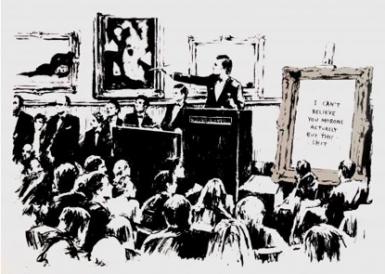

URBAN ART | From The Streets to The Auction House
While urban art has experienced a sprouting of acceptance and industry affirmed nods in the last 10 or so years, until recently, it did not have a clearly defined reputation in the art world. The following article will attempt to explain the development of the urban art movement and how it evolved from the side streets and alley-ways to high-profile private collections, auction houses and museums.
Fifty years after it first started appearing in our cities, art experts along with dealers, collectors and even the press finally started considering street art as an accepted artistic movement. The term ‘street art’ generally refers to artists who use the urban environment as an open arena where they create and freely exhibit their works to the general public. According to this definition, it seems that every artwork found on a public building or structure can be considered street art. However, if we take a closer look, it becomes more obvious that the process of defining this art movement is more complicated than what we think.
One categorically important element in the definition of street art is that it was born independently from the established art world. Contemporary urban installations from such artists like Richard Serra, Anish Kapoor and Christo/Jeanne-Claude, to name a few, are considered to be in the domain of public art rather than categorized as it’s derelict younger relative. Indeed, these high-profile public works are almost always commissioned and directly linked to a specific established arts program or institution.
Another important difference between urban art and commissioned public art is the content, goal and context of the work. Whereas many public works may address a specific academic or conceptual theme, urban art originated from and is influenced by city subcultures and is based on contemporary iconography attracting the attention of the general public.
Street artists originate from a variety of commercial and underground cultures such as pop, punk, cyber, comics, fashion, hip-hop and skateboarding. It is based on an iconographic design that shows heterogeneity in style, medium and procedures. Based on a heterogeneous community, street artists are established worldwide and interact between each other through online platforms, social media, exhibitions and festivals, the latter of which are becoming increasingly popular internationally.
Having defined the meaning of street art, another important question is how did street art attract the attention of prestigious galleries and museums as well as serious dealers, collectors and art market investors.
The internet and social media have played a crucial role in the development and acceptance of urban art on a mass public scale. Platforms such as Instagram and Facebook are commonly used to share images thus creating a global phenomena of very localized works. We can compare it to the contemporary art fairs in the established art market. A few of the most renowned street art events are ‘Life is Beautiful’ in Los Angeles, USA, the ‘Fame Festival’ in Italy and ‘POW Hawaii’, for which Andipa Gallery is excited to reveal that our represented artist Slinkachu will take part in the POW 2016 edition.
As commercial enterprise began to take notice of the growing popularity of the urban art scene, artists began appropriating their work in the format of ‘indoor’ commercially based works on canvas and prints. The first points of sale at this time were niche cultural venues such as street-wear shops. It didn’t take long for notorious brands such as Vans to understand the visual power of street art and have since forged innovative partnerships. A few artists even decided to invest in their own brand, Shepard Fairey for example, founded the successful clothing company OBEY.
Probably the most popular and internationally acclaimed street artist is the infamously unknown Banksy. His social and politically charged street works fueled by coverage in mainstream culture and media resulted in a high demand for commercially saleable original and multiples that allowed Banksy and other street artists to break into the secondary art market accessing galleries, museums and auction houses. Since 2007, important houses such as Sotheby’s, Christies and Bonham’s have begun to include urban art works as part of their contemporary art program, successfully selling works around the one million dollar mark.
Largely due to the success achieved by artists such as Banksy and Shepard Fairey, urban art earned its place within the institutionalized art world and continues to grow into 2015. Steaming from this recent acceptance and professional advocacy, a new generation of artists are establishing themselves as ‘contemporary urban artists’, connected with the street art community only now being commission for large public works and participating in high-profile gallery and museum exhibitions.
Andipa is proud to collect urban art along with our inventory of modern and post-war contemporary works. We have invested in street art for over 10 years and in 2007 presented one of the largest and most comprehensive Banksy solo exhibitions globally to date. We continue to invest in new contemporary urban artists such as British miniature street artist Slinkachu and are committed to providing professional services for our clients and collectors across this exciting new movement.

